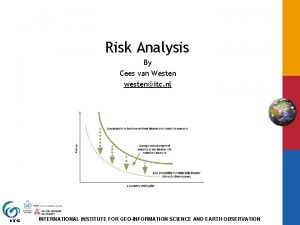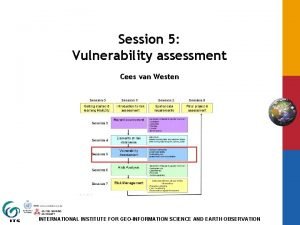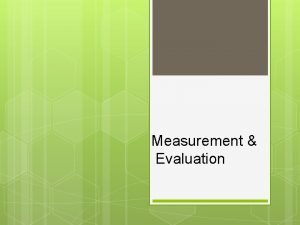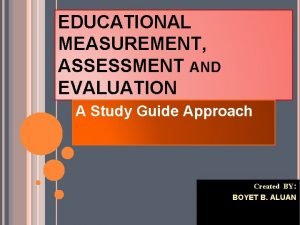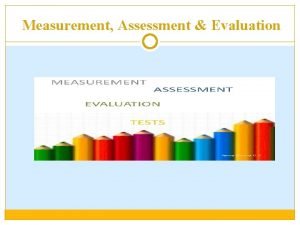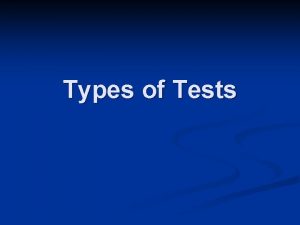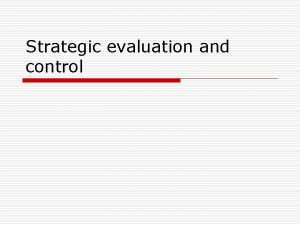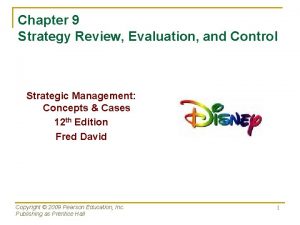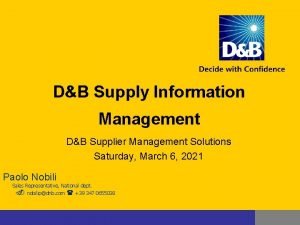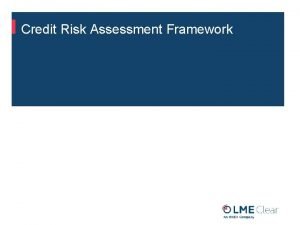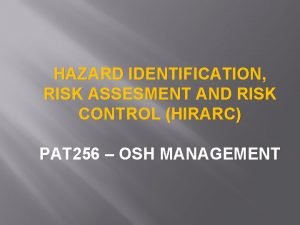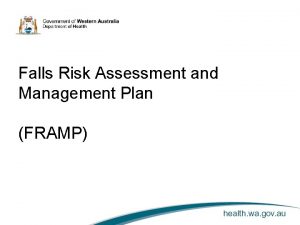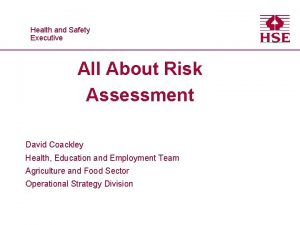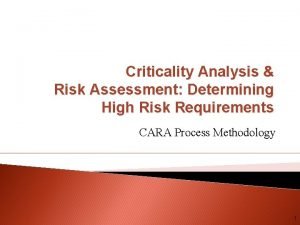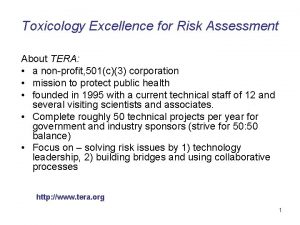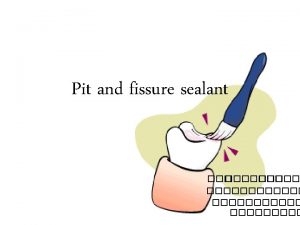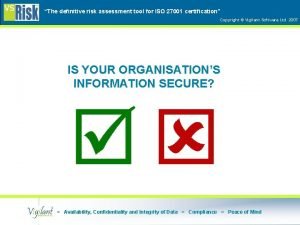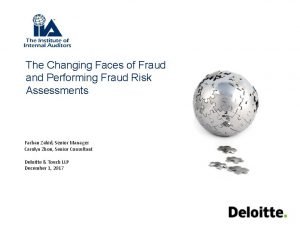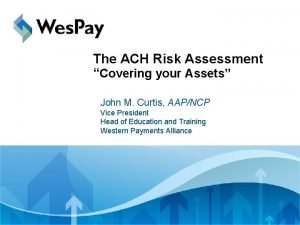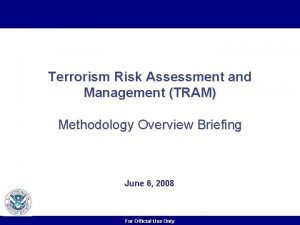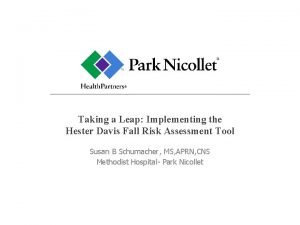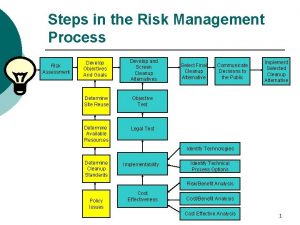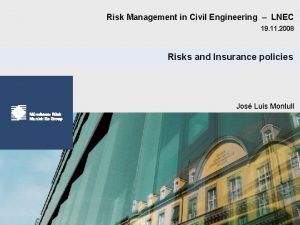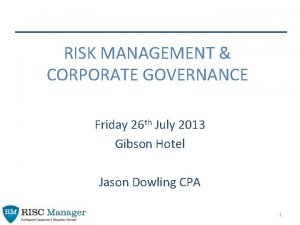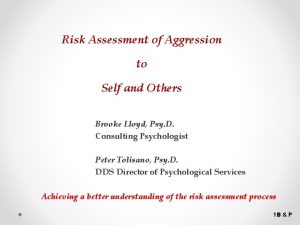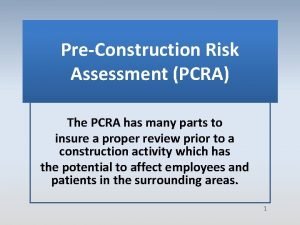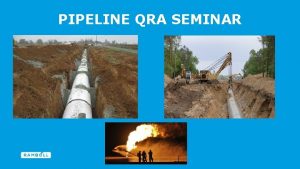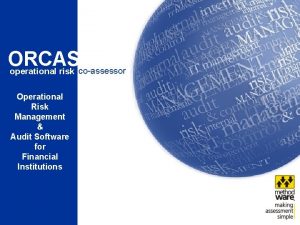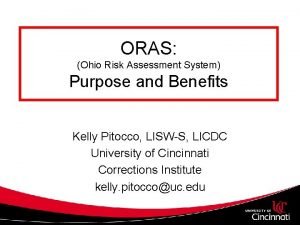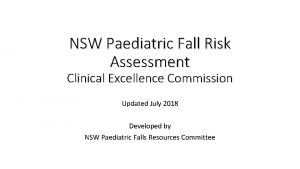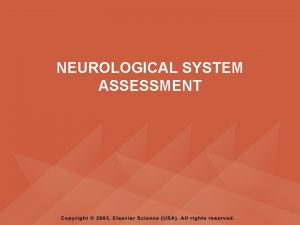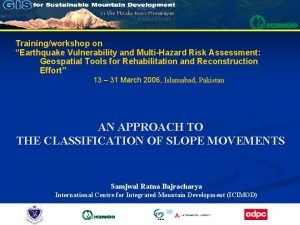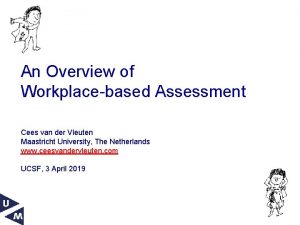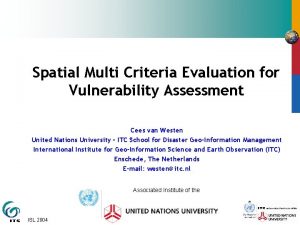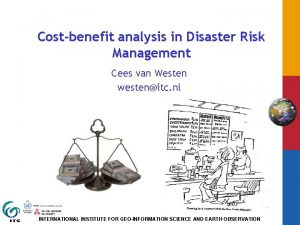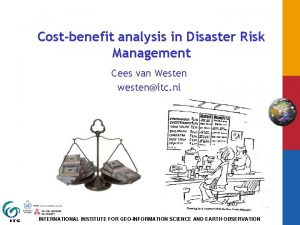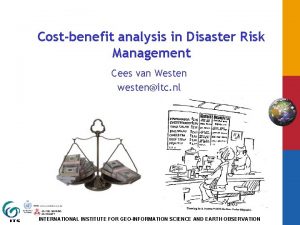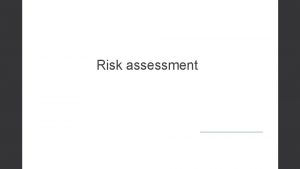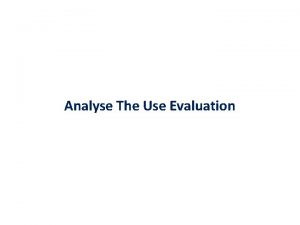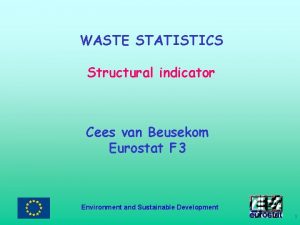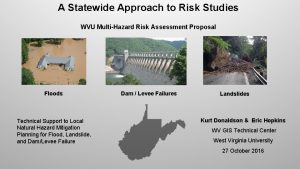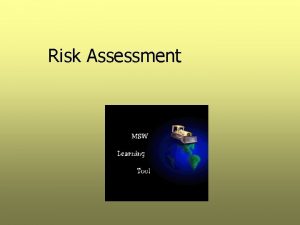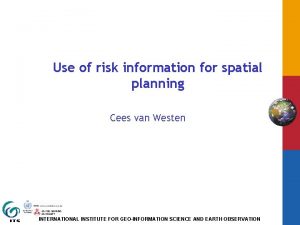Multihazard risk assessment and risk evaluation Cees van



















































- Slides: 51

Multi-hazard risk assessment and risk evaluation Cees van Westen INTERNATIONAL INSTITUTE FOR GEO-INFORMATION SCIENCE AND EARTH OBSERVATION

Programme for this week § Tuesday: Multi-hazard risk assessment § § Presentations of risk exercises Lecture on multi-hazard risk assessment & risk evaluation Guest lecture: (12. 30) Climate change scenarios GIS exercise: Multi-hazard risk assessment § Wednesday: Cost-benefit analysis § Lecture & practical § Thursday: Using risk information in Disaster Risk Management (disaster preparedness) § GIS simulation: Emergency response § Friday: Using risk information in spatial planning § Friday afternoon: Final project (Konversatorium)

Last part of the course § Practicals: § mark for the practical is based on 3 assignments (hazard, risk, and simulation exercise) § Theory exam: 26 May § Closed book exam. Partly multiple choice, partly open questions. Bring calculator. Takes apr. 2 hours. § Konversatorium: § On Friday I prsent a list of topics § You may also suggest your own topic (related to GIS for hazard and risk assessment) § Report of 10 -15 pages § Submit by 27 May § Maybe : presentation by SKYPE on 27 May.

Multi hazard risk assessment

From single to multi-hazard risk § This is a difficult step: § Hazard processes are very different § Models used are very different § Data availability is very different § Temporal probability is biggest problem § Vulnerability is second biggest problem § Huge amount of data is needed § Are the hazards independent? § Are they caused by the same trigger? § Are they in chain

MH Relationships: Spatial Cause Effect Avalanches Preparatory factors Torrential Shallow Rockfall landslides processes Floods Avalanches Shallow landslides Rockfall Torrential processes Floods After de Pippo et al. (2008) and Tarvainen et al. (2006) 6

Multi-hazard risk assessment Risk curves of the hazards due to windstorms, floods and earthquakes for the city of Cologne. These curves comes directly from multiple one-by-one probabilistic hazard curves (from Grunthal et al. , 2006)

Probabilistic risk assessment § Probabilistic techniques employ statistical analysis of historical datasets to simulate hazard intensities and frequencies across a country’s territory. § Includes the effect of all possible events, each one with different: § Probability of occurrence § Intensity and (uncertainty) § Includes physical vulnerability (and its uncertainty) § Results in loss probability curve

HAZUS (advanced) ISL 2004

Probabilistic Risk Modeling Hazard (i. e. earthquake) Vulnerability Damage Functions Exposure (i. e. houses) (of house to quake) Risk (i. e. probable losses) Disaster Impact Analysis - Scenario or Stochastic INFRASTRUCTURE ECONOMIC SOCIAL ENVIRONMENTAL

Hazard exceedance curves

Risk. Scape Open Source Multi-hazard risk assessment software: http: //riskscape. org. nz/home

Other projects on multi-hazards § § § § FEMA’s Software Program for Estimating Potential Losses from Disasters (HAZUSMH) http: //www. fema. gov/plan/prevent/hazus/ Geo. Sciences Australia http: //www. ga. gov. au/urban/projects/ramp/index. jsp Natural Hazard Research Center / Sydney – Peril. AUS Software http: //www. riskfrontiers. com/nhrcresearch/perilaus/pprazpagetables. htm Pacific Disaster Center: e. g. Asia Pacific Natural Hazards and Vulnerabilities Atlas http: //www. pdc. org/iweb/index. jsp http: //www. pdc. org/atlas/html/atlas-init. jsp Reducing Risk from Natural Hazards Program (RRNH), Canada http: //ess. nrcan. gc. ca/rrnh-rran/proj 4_e. php United Nations University - Multi-Hazards Urban Risk Assessment with Dynamic Spatial Information; In cooperation with University of Tokyo http: //www. unu. edu/esd/projects/hazardrisk. htm Center for Disaster Management and Risk Reduction Technology (CEDIM), University of Karlsruhe http: //www. cedim. de/english/13. php

Baysian event tree Bayesian Event tree for tsunami propagation, given that rock slide in Aknes has occurred (V= rockslide volume, R=run-up height). From Lacasse et al. , 2008

Event trees

Event trees

Fault tree analysis

Fault tree analysis

Population at risk Individual Risk Individual risk is the risk of fatality or injury to any identifiable (named) individual who lives within the zone impacted by a hazard, or follows a particular pattern of life, that might subject him or her to the consequences of a hazard. Societal Risk Societal risk is the risk of multiple fatalities or injuries in the society as a whole, and where society would have to carry the burden of a hazard causing a number of deaths, injury, financial, environmental, and other losses.

Individual risk Cause All causes (illness) Cancer Road accidents Accidents at home Fire Drowning Excessive cold Lightning Probability / year 1. 19 E-02 2. 80 E-03 1. 00 E-04 9. 30 E-05 1. 50 E-05 6. 00 E-06 8. 00 E-06 1. 00 E-07 Cause Rock climbing Canoeing Hang-gliding Motor cycling Mining Fire fighting Police Accidents at offices Probability / year 8. 00 E-03 2. 00 E-03 1. 50 E-03 2. 40 E-04 9. 00 E-04 8. 00 E-04 2. 00 E-04 4. 50 E-06 § Individual risk can be calculated as the total risk divided by the population at risk. § For example, if a region with a population of one million people experiences on average 5 deaths from flooding per year, the individual risk of being killed by a flood in that region is 5/1, 000, usually expressed in orders of magnitude as 5× 10− 6.

How to express risk? § Suppose: What is the risk of flying by airplane? Is it higher than driving a car? ISL 2004

f-N curves Usually used to express societal risk. Important to define acceptable / tolerable risk Left: f-N curves showing the number of Fatalities against annual frequency. For natural and manmade hazards

How to generate F-N curves § the frequency of events which causes at least N fatalities is plotted against the number N on log scales § The difference between the frequency of events with N or more fatalities, F(N), and that with N+1 or more, F(N+1), is the frequency of events with exactly N fatalities, usually represented by f(N), with lower-case f. § Because f(N) must be non-negative, it follows that F(N) ≥ F(N+1) for all N, so that FN-curves never rise from left to right, but are always falling or flat § The lower an FN-curve is located on the FN-graph, the safer is the system it represents, because lower FNcurves represent lower frequencies of fatal events than higher curves.

Societal risk § The value F(1) is the frequency of accidents with 1 or more fatalities, or in other words the overall frequency of fatal accidents. This is the left-hand point on FN-curves, where the curve meets the vertical axis (usually located at N = 1 with logarithmic scales). § F-N curves can be constructed based on historical data in the form of number of events (floods, landslides, etc) and related fatalities § They can also be based on different future risk scenarios, in which for a number of events with different magnitudes the number of casualties is estimated

How to calculate F-N curves § In this exercise you will calculate F-N curves for accidents that have occurred in Europe in the period 1967 to 2001. § Three different types of accident data area available: for roads, railroad and aviation. § The analysis is based on empirical data, collected from historical accidents records.

How to calculate F-N curves § § § First calculate the total number of fatalities for road, railroad and aviation accidents by multiplying the number of events with the fatality class. Also calculate the average number of fatalities per year. . Then calculate the cumulative number of events, starting with the lowest one in the table (related to 146 fatalities) and summing them up upwards. Then calculate the cumulative frequency of events per year, by dividing the cumulative number by the number of years.

How to calculate F-N curves § § Plot these values in the graph indicated at the bottom of the spreadsheet in a log -log manner, with Fatalities (N) or the X-axis, and the cumulative frequency per year on the Y-Axis. Compare the results. What can you conclude on the: § § Severity of the accident type Frequency of the accident type

Analyzing changing multi-risk

Exercise today § Create risk curves § Risk = H * V * A § R = PT * P L * V * A

Exercise today

Seismic risk • • • Step 1: Defining earthquake scenario. Step 2: Calculate the attenuation Step 3: Calculate soil amplification Step 4: Convert PGA to MMI Step 5: Apply Vulnerability Functions for Building types Step 6: Apply Vulnerability Functions for Infrastructure types Step 7: Apply Vulnerability Functions for casualties If additional information is available: Step 8: Apply cost information to the buildings and combine with vulnerability to calculate losses for different return periods. Step 9: Combine loss information for different return periods and calculate the risk by adding up the losses from these periods. Step 10: Combine information and make summary ISL 2004

Seismic risk • Risk = Hazard * Vulnerability * Amount Return period Probability Loss Risk ISL 2004 15 0. 067 1323 88 35 0. 029 4850 139 50 0. 020 8945 179 60 0. 017 10991 183

Flood hazard modeling § Sobek: a two dimensional hydraulic model. § Input: § Digital Surface Model (Lidar) § Discharge data § Roughness data (landuse) • Output: Flood depth • Flow velocity (Per time step) Discharge • 100 25 10 5 ISL 2004

Flood risk 5 years 50 years 100 years 25 years Mapping units 25 years Hazard polygons ISL 2004 Buildings Affected

Flood risk § Risk = Hazard * Vulnerability * Amount ISL 2004

Flood risk • Risk = Hazard * Vulnerability * Amount Return period 5 10 25 50 100 Probability 0. 2 0. 1 0. 04 0. 02 0. 01 Loss 33 74 192 405 1096 Risk 7 7 8 8 11 ISL 2004

Calculating buildings in hazard zones Building map Susceptibility Calculates the number of houses in High, Moderate and Low susceptibility zones using a Building footprint map Cross 4426 buildings ISL 2004 9645 buildings 22019 buildings

Quantitative risk assessment Only susceptibility Still to do Known now Risk = Hazard * Vulnerability * Amount How much percentage of the high, moderate and low hazard classes may be affected by landsides? In which period will these landslides occur? What is the vulnerability to landslides? Results using mapping units High Moderate Low 4426 buildings 9645 buildings 22019 buildings Hazard = Spatial probability * Temporal probability The temporal probability that landslides may occur due to a triggering event. Here we will link the return period of the triggering event with the landslides that are caused by it. We have differentiated return periods of: 50, 100, 200, 300 and 400 years. The spatial probability that a particular area would be affected by landslides of the given temporal probability. This is calculated as the landslide density within the landslide susceptibility class. ISL 2004

From susceptibility to hazard Landslide_ID map Million dollar information!!! If the indication of the high, moderate and low areas susceptibility is correct, different landslide events with different return periods will give different distributions of landslides in these classes. The probability can be estimated by multiplying the temporal probability (1/return/period for annual probability) with the spatial probability (= what is the chance that 1 pixel is affected) Landslide related to different return periods Susceptibility Cross Density in high ISL 2004 Densi ty in

Calculating hazard Assumption is that events with a larger return period will also trigger those landslides that would be triggered by events from smaller return periods Susceptibility classes Return periods ISL 2004

Calculating Vulnerability Estimating landslide vulnerability is very complex. It requites knowledge on the building types and on the expected landslide volumes and velocities. These are difficult to estimate. In many study landslide vulnerability of buildings is simply taken as 1, assuming complete destruction of the elements at risk. This would, however, in our case give too Simple assumption: The more buildings there are with 3 floors or higher, the lower will be the landslide vulnerability, as it becomes less likely that large buildings will be destroyed by landslides. exaggerated values of risk. ISL 2004 Vuln: =iff(Per. Vacant=1, 0, 1 -(Perc 3 floor+Percover 3 floor))

Calculate losses Losses = Spatial Probability * Consequences Losses = Spatial P * V * A Loss_50_high: =0. 0181*vuln*nr_b_high Loss_50_moderate: = 1. 31199 E-06*vuln*nr_b_moderate Loss_50_low: = 5. 96345 E-07*vuln*nr_b_low etc ISL 2004

Calculate losses Losses for a return period = sum of losses in high, moderate and low susceptibility areas What can you conclude when you compare the spatial probabilities and consequences for the high, moderate and low susceptibility classes ? ISL 2004

Calculate risk Period ISL 2004

Calculate total risk Total Risk = Area under curve Two methods: 1: Add trendline and integrate trendline 2: Use graphical method with triangles and rectangles ISL 2004

Combine hazard types ISL 2004

Risk curves § Plotting the return period on the X-axis and the Losses on the Yaxis § Plotting the return period on the X-axis and the annualized risk on the Yaxis § Plotting the losses on the X-axis and the annual probability on the Y-axis. § Such a risk curve is also called the Loss Exceedance Curve (LEC).

Scenario Results Return Period Annual Building Losses Specific RP Probability V*A Annualized Risk PT *V*A PT Flood_10 y Flood_50 y Flood_100 y Landslide_50 y Earthquake 0. 1 14. 010 50 0. 02 260. 05 5. 201 100 0. 01 810. 7 8. 107 50 0. 02 29. 5 0. 590 Landslide_100 y 100 0. 01 314 3. 140 Landslide_200 y 200 0. 005 1286. 1 6. 431 Landslide_300 y 300 0. 003333333 2422. 2 8. 074 Landslide_400 y 400 0. 0025 4143. 4 10. 359 Seismic_VI Technological 10 50 0. 02 1248. 77 24. 975 Seismic_VII 100 0. 01 4557. 23 45. 572 Seismic_VIII 200 0. 005 9130. 37 45. 652 Seismic_IX 500 0. 002 14459. 05 28. 918 Tech_sc 1 50 0. 02 144. 29 2. 886 Tech_sc 2 500 0. 002 2596. 69 5. 193 Risk Curves 0. 1 0. 09 Annual Probability 0. 08 Landslide 0. 07 0. 06 Flood 0. 05 0. 04 Earthquake 0. 03 0. 02 Technological 0. 01 0 0 1000 · · 2000 3000 4000 5000 6000 7000 8000 9000 Losses (Nr. Buildings) 10000 11000 12000 13000 14000 15000 Make 3 risk curves: Plot the Return Period on the X-axis and the Building Losses on the Y-axis Plot the Return Period on the X-axis and the Specific Annualized risk on the Y axis Plot the Building losses on the X-Axis and the Annual Probability on the Y-Axis.

Calculate area under the curve § Determine in Excel a trendline for the curve and calculate the area under the curve. § Divide the area under the curve in triangles and squares


Calculate total risk Total Risk = Area under curve Two methods: 1: Add trendline and integrate trendline 2: Use graphical method with triangles and rectangles ISL 2004
 Cees van westen
Cees van westen Cees van riel
Cees van riel Kh-3021f combo
Kh-3021f combo Cuento antiguas cacerías
Cuento antiguas cacerías Big cees
Big cees Cees busker
Cees busker Market risk assessment
Market risk assessment Concept map of measurement assessment and evaluation
Concept map of measurement assessment and evaluation Prognostic test
Prognostic test Community health planning and implementation
Community health planning and implementation Chapter 11 assessment and evaluation of sports injuries
Chapter 11 assessment and evaluation of sports injuries Continuity assessment record and evaluation
Continuity assessment record and evaluation Concept of measurement assessment and evaluation
Concept of measurement assessment and evaluation Difference between assessment and evaluation
Difference between assessment and evaluation Fatality assessment and control evaluation
Fatality assessment and control evaluation Richard rumelt criteria for strategy audit
Richard rumelt criteria for strategy audit Strategy evaluation assessment matrix
Strategy evaluation assessment matrix Evaluation n
Evaluation n D&b supplier evaluation risk rating
D&b supplier evaluation risk rating Credit risk evaluation framework
Credit risk evaluation framework Hirac form example
Hirac form example Framp
Framp Health and safety risk assessment template
Health and safety risk assessment template Population health risk assessment and management
Population health risk assessment and management Criticality analysis and risk assessment
Criticality analysis and risk assessment Residual risk and secondary risk pmp
Residual risk and secondary risk pmp Business vs financial risk
Business vs financial risk Relative risk
Relative risk Population attributable risk
Population attributable risk Characteristics of portfolio assessment
Characteristics of portfolio assessment Define dynamic assessment
Define dynamic assessment Portfolio assessment matches assessment to teaching
Portfolio assessment matches assessment to teaching Toxicology excellence for risk assessment
Toxicology excellence for risk assessment Caries risk assessment form
Caries risk assessment form Iso 27001 tool
Iso 27001 tool Check kiting example
Check kiting example Ach risk assessment template
Ach risk assessment template Tram risk assessment
Tram risk assessment Hester fall risk assessment
Hester fall risk assessment Asa airway
Asa airway Risk management phases
Risk management phases Civil engineering insurance policies
Civil engineering insurance policies Risk assessment meme
Risk assessment meme 1/2-3/10
1/2-3/10 Aggression risk assessment
Aggression risk assessment Pcra risk assessment
Pcra risk assessment Qra software
Qra software Sarah risk assessment
Sarah risk assessment Orca risk assessment framework
Orca risk assessment framework Ohio risk assessment
Ohio risk assessment Falls risk assessment tool nsw
Falls risk assessment tool nsw Risk assessment pyramid
Risk assessment pyramid
